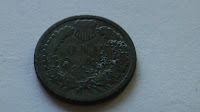Decided to try my coil around an area of the oldest park in town which does not get any attention. By "attention" I mean a section that virtually never gets any modern human activity and as such there are few changes made to it over the years. So I started off where I left the last time I was there and came across a 1944 wheat penny. About 20 minutes into the hunt, I got a strong signal which was very similar to my Mercery dime discovery - right on the money! This time it was older -- 1923 -- and in fairly good condition.
The next possible signal I got did not even seem like anything special. It was "iffy" at best. For any Xterra owners out there, the best I can describe it is a faint signal (as in, it barely overcame my threshold tone) and had a very narrow window that you hear it. The difference between this possibly good signal and a high VDI (42-46) signal from some aluminum scraps was the fact it was CONSISTENT at all types of angles swinging the coil. Junk will not behave like this, instead giving a much more erratic signal. The difference is subtle hopefully I now have a better feel for this in the field.
Anyway, what happened next can only be described as the greatest set of finds in my detecting career to this point. About 5-6inches down in very compacted and dry soil, my glove revealed the silvery edge of a large coin with stars around the perimeter. Could it be what I thought it was? Oh yes, I laid my eyes on my very own Barber quarter - 1902!!
My oldest coin to date. I swung over the hole again. There was still a signal coming out of there - you have got to be kidding me! My pinpointer guided me to more shiny silver off to the edge of where I made my plug. This time I was rewarded two fold... another Mercury dime - 1918 and sandwiched with it was my very first standing liberty quarter. But as I pulled it out I realized my screwdriver I had used to loosen the compacted dirt had scrapped the 3 o'clock position, taking out the E Plurus unum. The coin had enough wear on it to make the date unreadable but the reverse revealed it to be minted after 1917 (Type II).
Now no more than a foot from this three silvers in one hole was a solid penny signal near a tree that I decided to dig to see if it was a wheatie. At first glance, I knew it was not a wheat penny. The reverse was the back of my first Indian Head Penny! The obverse had some gunk on it so I waited to clean it at home. Imagine my surprise as I revealed the date - 1883! My oldest coin to date. It is going to take some time before I get down from this "cloud nine."
I can only hope that I have finally figured out how to read silver with my machine because now all I can think about is getting my next piece.
A blog covering my exploration into the hobby of metal detecting throughout the state of Montana
Friday, July 19, 2013
Saturday, July 13, 2013
Eat your Wheaties, get a Merc
Don't just swing anywhere
Lately I have been hunting in parks that are adjacent to some of the more historical landmarks in town. The focal point of the hunt has not been on the "center of the action" spots that most everyday people would think would be the place to swing your coil. Instead, I look at an area and see if there is any evidence of recent soil disturbance. What you aim for is areas that have not gotten any attention from the maintenance crew. These grounds tend to hold the older coin at a shallower depth than most other areas where there is often many rounds of topsoil removal and reseeding.The Wheaties keep coming
Lately I have not shied away from the obvious "penny" signals. Sometimes these come out of the ground as old wheat pennies, and sometimes come out of unexpected places. I recently pulled a 1926 Wheat out of a pile of silt that had piled up from a wall drain - only 1 inch from the surface! Oldest one to date, 1919, came from a strip of grass across from the ol' swimming hole.

The first Mercury Dime, quite the surprise!
While on my hunt right next to an old train depot, I got an unusual VDI signal coming from my XTerra 705 that I have not seen before (at least one that was this consistent). Keep giving a solid "46" from all angles I approached it so I decided to check it out. About 5-6inches down, what I initially imagined to be just some type of "can slaw" ended up being a nice shiny silver piece for me. Imagine my surprise when I took it out thinking it was a silver Rosie and it ended up being my very first Mercury dime - dated 1942! That find made my day. After some research, I discovered 1942 had a small portion of Mercs that were minted with a "2" stamped over last "1" in "1941" - these coins are worth about $250-600 depending on the condition. Closer inspection revealed I did not have this error coin but it was exciting for a brief moment to think I found something potentially rare.Have some other finds to post from other hunts, so stay tuned.
Labels:
1919,
1926,
1942,
1944S,
can slaw,
historic area,
merc,
mercury dime,
park,
silt,
train depot,
VDI,
wall drain,
wheat penny,
XTerra 705
Location:
Great Falls, MT, USA
Subscribe to:
Comments (Atom)










